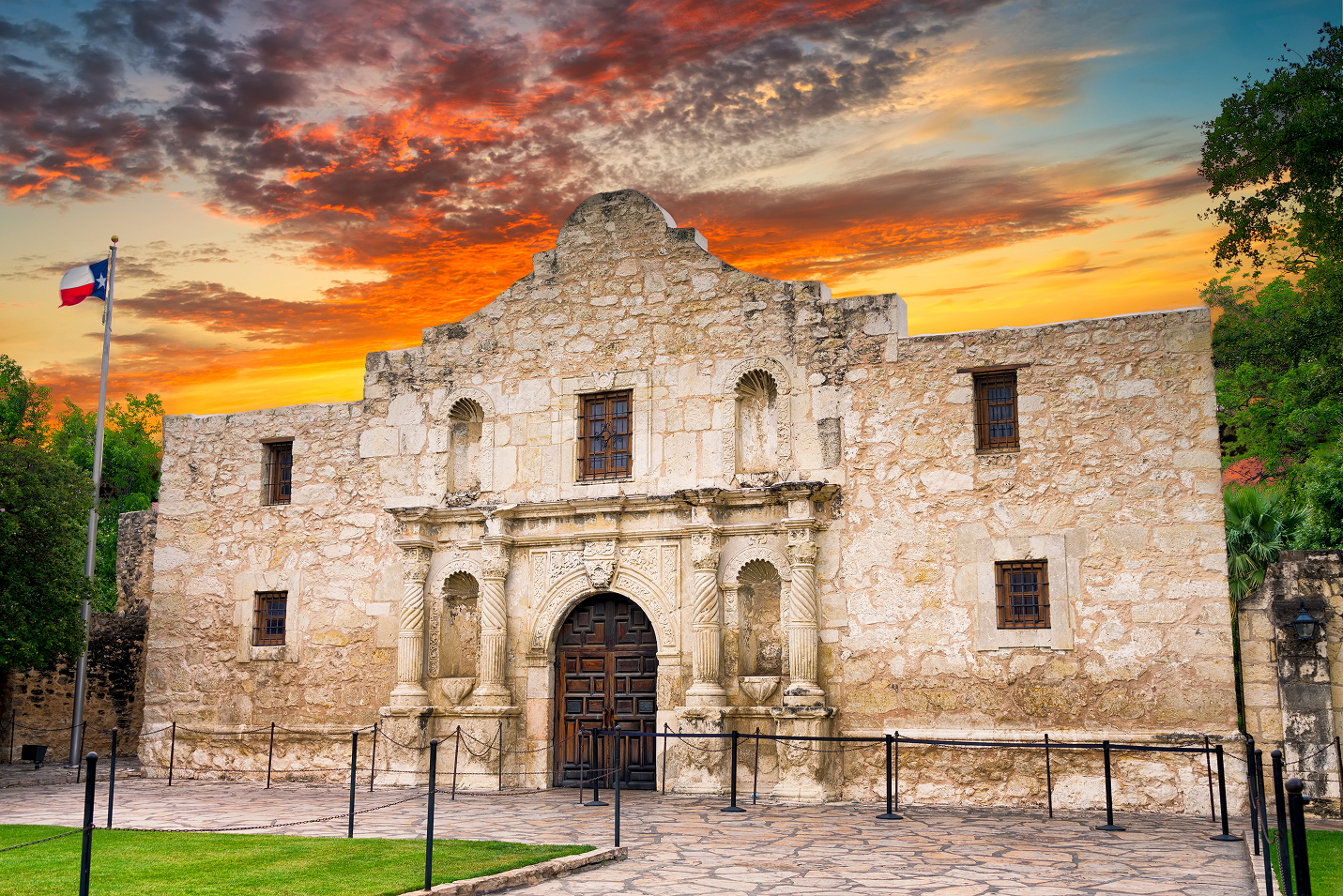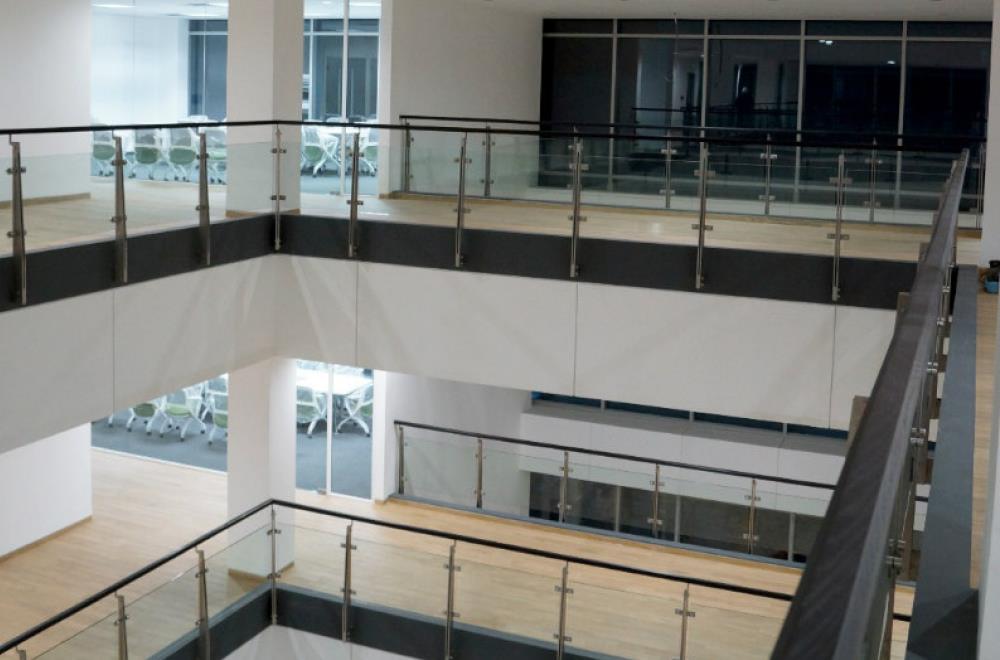
People know Texas for more than just its large landscapes and history - they also recognize its unique architecture in its lively cities. Every building in Texas has a unique story to tell.
This includes tall skyscrapers and old missions. These stories reveal how the state has changed over time. Here's a look at the 15 best buildings in Texas that are a must-see for architecture enthusiasts and tourists alike.
The Alamo, located in San Antonio, Texas, is a vital landmark in any exploration of Texan architecture. Famous for its pivotal role in the 1836 battle that was key to Texas' independence from Mexico, this iconic mission is a prime example of Spanish colonial architecture. It stands as a testament to the resilience and quest for freedom that defined the Texan spirit during its fight for independence.
The structure of The Alamo, with its distinctive facade and rugged limestone walls, offers a glimpse into the past, providing insights into the architectural styles and construction techniques of the time. It also serves as a cultural symbol, embodying the bravery and sacrifice of those who fought there. Today, The Alamo is not only a museum but also a memorial, attracting millions of visitors each year who come to pay homage to the site's historical significance and to admire its architectural beauty.
In addition to its historical and architectural importance, The Alamo also plays a role in educating the public about the early days of Texas and the conflicts that shaped its identity. Through various exhibitions and educational programs, it offers visitors a comprehensive understanding of the historical context and the enduring impact of the events that took place there. Thus, The Alamo remains a poignant reminder of the struggles for freedom and identity in American history.

The Texas State Capitol, located in the heart of Austin, is a remarkable edifice that surpasses even the U.S. Capitol in size, asserting its significance with grandeur. Built in the late 19th century, it exemplifies Renaissance Revival architecture—a style marked by its classical symmetry, rounded arches, and ornate detailing. Constructed primarily from distinctive red granite sourced from nearby quarries, the building emanates a robust and stately presence that mirrors the spirit of Texas governance.
The capitol's most striking feature is its stunning rotunda, which soars upwards to a massive dome, offering an awe-inspiring view for visitors and serving as a central hub for the building's intricate layout. The dome itself is topped with the "Goddess of Liberty," a statue that symbolizes the state's independent spirit and commitment to freedom. Surrounding the Capitol are sprawling grounds that include various monuments and landscaped gardens, which provide a scenic setting for public gatherings and state events.
As a center of Texas politics, the Capitol hosts the sessions of the Texas legislature and the offices of the governor, serving as a bustling hub of political activity and decision-making. It is not only a functional space for governance but also a repository of art and history, housing many portraits and statues that depict significant figures and events in Texas history.
Educational tours and exhibits within the Capitol offer insights into the architectural styles, historical significance, and legislative processes, making it a comprehensive educational experience for visitors. The Texas State Capitol is more than just a building; it is a symbol of Texan pride and political heritage, standing as a testament to the state's rich history and its ongoing story of governance and public engagement.
The Kimbell Art Museum in Fort Worth, Texas, stands as a testament to the genius of its designer, the celebrated architect Louis Kahn. Known for his mastery in the use of natural light and minimalist structures, Kahn's design for the Kimbell Art Museum is no exception, making it a hallmark of modern architecture. The museum's building is acclaimed for its elegant simplicity and the harmonious way it combines concrete and travertine with vast, open spaces that invite light to play across the surfaces of its interior.
One of the museum's distinctive features is its innovative use of natural lighting, which Kahn achieved through a series of vaulted gallery spaces topped with skylights. These carefully designed openings allow light to filter gently into the galleries, illuminating the artworks in a way that enhances their beauty without exposing them to the damaging effects of direct sunlight. This thoughtful integration of light and architecture ensures that each visitor's experience of the art is both unique and deeply personal.
The layout of the museum is deliberately straightforward, fostering a serene and contemplative atmosphere that encourages visitors to engage deeply with the art. This uncluttered approach not only highlights the artwork but also creates a dialogue between the art, the architecture, and the surrounding landscape. The museum's setting and its design reflect Kahn's philosophy that a museum should serve as a temple of sorts, a sacred space for art.
Beyond its architectural significance, the Kimbell Art Museum hosts an impressive collection of artworks ranging from ancient to contemporary, featuring works by artists such as Caravaggio, Rembrandt, and Picasso. Its educational programs, special exhibitions, and public events make it a dynamic cultural hub in Fort Worth.
Overall, the Kimbell Art Museum offers more than just a showcase for art; it provides an experience that is enriched by its architectural context, making it a must-visit destination for lovers of both art and architecture.
The Bank of America Plaza in Dallas is an iconic feature of the city's skyline, renowned for its striking stature and distinctive green argon lighting that casts a vibrant glow across the cityscape at night. This skyscraper is a quintessential example of modernist architecture, characterized by its sleek, reflective glass facade and sharp, clean lines that ascend into the sky.
Standing as one of the tallest buildings in Dallas, the Bank of America Plaza not only dominates the skyline but also symbolizes the city's economic vitality and modern ambition. The building's use of green argon lights is not just for aesthetic appeal; it also highlights its unique architectural features, making it a prominent landmark and a beacon in the urban night.
The plaza's design emphasizes functionality and style, utilizing a minimalist approach that is typical of the modernist era. Its reflective glass surface not only contributes to its visual impact but also offers practical benefits, such as reducing heat gain and maximizing natural light inside the building. This not only enhances the energy efficiency of the building but also provides a pleasant work environment for those inside.
The Bank of America Plaza is more than a business hub; it's a cultural and social landmark that attracts visitors and professionals alike. Its ground level features public spaces that host various events, fostering community engagement and adding to the vibrancy of downtown Dallas.
Overall, the Bank of America Plaza is not just a testament to the advancements in architectural design during the modernist era but also a symbol of Dallas's dynamic growth and its status as a major metropolitan center. Its presence in the Dallas skyline is a constant reminder of the city's thriving business environment and its commitment to contemporary urban aesthetics.
The Frost Bank Tower in Austin is a standout feature of the city's skyline, instantly recognizable by its unique pointed summit and shimmering blue glass facade. This architectural gem blends gothic influences with contemporary design elements, creating a modern icon that encapsulates the city's innovative spirit and aesthetic sensibility.
The tower's design is notable for its sharp, angular lines and a crown that resembles an owl from certain angles, which has become a topic of local folklore. This gothic touch adds an element of intrigue and depth to the building's otherwise modern silhouette. The use of blue glass not only contributes to the building's striking appearance but also reflects the changing colors of the Texas sky, integrating the structure seamlessly with its surroundings.
Frost Bank Tower is more than just a visually compelling structure; it also represents a shift in architectural trends towards incorporating more dynamic and distinctive designs in urban landscapes. The building's layout and features, including its high ceilings and open floor plans, are designed to enhance natural light penetration and promote a more fluid, collaborative work environment.
As a center of business and innovation, Frost Bank Tower houses numerous offices and commercial spaces, serving as a hub for both established companies and emerging businesses. Its presence in the heart of Austin's downtown area also contributes to the city's economic development, drawing professionals and visitors alike to this bustling metropolitan center.
Overall, Frost Bank Tower is a symbol of Austin's growth and its embrace of modern architectural styles while maintaining a connection to traditional design elements. It not only enhances the city's skyline but also serves as a testament to Austin's ongoing transformation and its status as a contemporary urban hub.
Bishop’s Palace, also known as Gresham's Castle, is a Victorian-style mansion located in Galveston, Texas, renowned for its architectural grandeur and historical significance. This exquisite residence showcases ornate woodwork and intricate carvings that epitomize the craftsmanship of the Victorian era. Its robust construction has notably withstood the great hurricanes of Galveston, serving as a testament to the durability and quality of its design.
Constructed in the late 19th century, the mansion features a combination of fine materials, including stained glass, rare woods, and luxurious stone. The attention to detail in the wood carvings and the opulent interior decorations reflect the affluence and aesthetic preferences of the time. Bishop’s Palace is not merely a residence; it is a canvas that displays the elaborate and often extravagant architectural styles popular among the American elite during the Victorian period.
The resilience of Bishop’s Palace is particularly noteworthy. It has survived numerous natural disasters, including the infamous 1900 hurricane that devastated much of Galveston. This resilience highlights the exceptional engineering and construction techniques of the era, designed to withstand the harsh coastal environment.
Today, Bishop’s Palace is open to the public, offering tours that allow visitors to step back in time and experience the splendor of Victorian Galveston. Its preservation as a historical landmark allows for educational
Pennzoil Place in Houston, designed by the acclaimed architect Philip Johnson, is a striking example of postmodern architecture that has become a landmark in the city's skyline. The building is distinguished by its two trapezoidal towers of glass and steel, which are designed to appear as if they are sliding past each other. This unique design not only creates a dynamic visual effect but also symbolizes the innovative and forward-thinking spirit of Houston.
The use of glass and steel allows for a reflective surface that mirrors the Texas sky and urban surroundings, integrating the structure with its environment. The design breaks away from traditional architectural forms, embracing irregular shapes and playful, yet elegant, structural features. This has set Pennzoil Place apart as an icon of postmodernism, characterized by its rejection of conventional aesthetics and its emphasis on form over function.
Beyond its architectural significance, Pennzoil Place also serves as a functional hub for business within Houston. The twin towers house offices for various companies, contributing to the city's bustling economic activity. Its central location in the downtown area makes it a focal point for both business professionals and architecture enthusiasts.
Pennzoil Place is not just a building; it's a statement of art and architectural philosophy that reflects the boldness and creativity of its era. As a prominent example of postmodern architecture, it continues to inspire architects and designers, influencing the evolution of urban landscapes with its innovative approach to form and style.
The museum, often referred to as "The Prado on the Prairie," is a renowned cultural institution located in the heart of the Midwest. It houses an impressive collection of art spanning various periods and styles, attracting visitors from near and far.
The museum's architecture is also a sight to behold, with its grand facade and intricate details. Inside, visitors can explore galleries filled with masterpieces by both local and international artists, providing a comprehensive overview of art history. The museum's reputation as a cultural hub in the region has earned it the nickname "The Prado on the Prairie," highlighting its significance and impact on the local community.
It houses a vast collection of Spanish art, one of the largest collections outside Spain. Its traditional architecture is reminiscent of a Spanish villa, enhancing its cultural offerings.
The Perot Museum of Nature and Science in Dallas is a captivating blend of educational facility and architectural marvel. Its bold, futuristic design, characterized by a cube-like structure encased in glass and textured panels, not only draws attention but also underscores its commitment to sustainability and technology. This striking design, featuring a rough-textured exterior that mimics the appearance of rock strata, serves as a visual metaphor for the natural sciences, while the smooth glass elements reflect the museum’s focus on technology and the future.
Designed with environmental consciousness in mind, the museum incorporates various sustainable features, such as a rainwater collection system and solar-powered water heaters, demonstrating how modern buildings can minimize their ecological footprint while maximizing functionality. These elements are integral to the museum’s mission to educate the public about science and the environment.
Inside, the Perot Museum is just as impressive, with five floors of permanent exhibit halls that explore topics from dinosaurs and ecosystems to engineering and innovation. Interactive displays and state-of-the-art technology engage visitors of all ages, making science accessible and entertaining. Its emphasis on hands-on learning exemplifies the modern approach to science education, encouraging curiosity and critical thinking among its visitors.
The museum’s location at the heart of Dallas further enhances its role as a cultural and educational hub, attracting both locals and tourists. By integrating innovative architecture with educational objectives, the Perot Museum of Nature and Science stands as a symbol of how public spaces can inspire and facilitate learning and discovery in the 21st century.
This historic cathedral in San Antonio stands as one of the oldest active cathedrals in the United States, serving as both a cultural and spiritual cornerstone for the community. Its architecture, a harmonious blend of Gothic and Romanesque styles, features pointed arches, ribbed vaults, and heavy, rounded stone walls that evoke a sense of historical depth and enduring faith.
The cathedral's design reflects the rich heritage and religious traditions brought by early European settlers, while also embodying the spirit of San Antonio's diverse cultural landscape. The intricate stonework and detailed facades not only showcase the artistic craftsmanship of the past but also provide a stunning backdrop for the many ceremonies and services held within its walls.
As a spiritual center, the cathedral plays a pivotal role in the community, hosting regular worship services, weddings, and cultural events that draw visitors from near and far. It also serves as a beacon of faith and hope, offering solace and a sense of continuity amidst the bustling urban environment of San Antonio.
Beyond its religious functions, the cathedral is a treasure trove of art and history. It houses numerous artifacts, statues, and artworks that chronicle the story of the city and its people. Educational tours and cultural programs further highlight its significance, making it not only a place of worship but also a hub of cultural learning and appreciation.
Overall, this historic cathedral remains a vital part of San Antonio's identity, preserving the legacy of its past while continuing to serve and inspire future generations.
The Fort Worth Water Gardens, located in the heart of Fort Worth, Texas, are a unique blend of architectural innovation and urban park tranquility. Designed by the renowned architects Philip Johnson and John Burgee, this space transforms the concept of a public park into an interactive, multi-sensory experience centered around water.
The Water Gardens feature a variety of water-based displays, each designed to offer a different auditory and visual experience. The most striking is the "Active Pool," where water cascades down terraced steps into a central pool, creating a powerful auditory impact and a mesmerizing visual effect. This area invites visitors to descend into the vortex of cascading water, enveloping them in a cool and misty atmosphere.
Another notable area is the "Quiet Pool," where water gently flows over a polished stone surface and disappears into a serene pool surrounded by towering cypress trees. This section of the gardens provides a stark contrast to the Active Pool, offering a peaceful retreat where visitors can enjoy quiet reflection and escape from the urban hustle.
The "Aerated Pool" features multiple spray fountains that create a lively and playful environment, ideal for families and children. The sound of splashing water and the cool breezes generated by the fountains add to the refreshing nature of the gardens.
Set against the backdrop of Fort Worth’s downtown skyline, the Water Gardens are not only a refuge from the city's heat but also a testament to the creative possibilities of urban landscape design. The integration of water, stone, and greenery makes the Water Gardens a pivotal cultural and recreational spot in Fort Worth, attracting visitors who seek a moment of peace or a unique experience within the urban environment.
Overall, the Fort Worth Water Gardens stand out as an exemplary public space that combines aesthetic beauty, architectural ingenuity, and functional public engagement, enhancing the cultural fabric of Fort Worth.
The Bass Performance Hall, located in the heart of Fort Worth's cultural district, is renowned as one of Texas's premier venues for the performing arts. Its angelic limestone façade and design, reminiscent of traditional European opera houses, endow it with a grandeur that makes it a cultural gem in the city.
Architecturally, the hall is distinguished by two 48-foot-tall limestone angels that grace its grand entrance, creating an ethereal and welcoming atmosphere. These sculptures are not only striking visual elements but also symbolize the hall's dedication to the arts and its role as a guardian of cultural heritage.
Inside, the Bass Performance Hall boasts a classic European opera house layout with luxurious box seating and an ornate, multi-tiered auditorium. The hall's interior is adorned with rich detailing, including elaborate murals and gold-leaf embellished moldings, which enhance the overall aesthetic and acoustical experience. The meticulously designed space ensures superb sightlines and sound quality, making every performance a captivating experience for the audience.
The hall's programming includes a wide variety of performances, from classical music concerts and opera to Broadway productions and modern dance, reflecting its role as a dynamic center for the arts. Its presence in Fort Worth not only enriches the local cultural scene but also draws performers and audiences from around the globe, contributing significantly to the city's reputation as a cultural hub.
In addition to its performance schedule, Bass Performance Hall also serves as an educational resource, hosting school matinees and community outreach programs that aim to inspire and nurture a love for the arts. This commitment to community involvement underscores its role as more than just a venue; it is a pivotal institution within Fort Worth's cultural life.
Overall, Bass Performance Hall is not merely a venue; it is a beacon of cultural excellence and architectural beauty, contributing immensely to the artistic landscape of Fort Worth and beyond.
The Moody Gardens Pyramids in Galveston stand as a striking architectural and functional marvel, blending educational facilities with awe-inspiring conservatories. These massive glass structures, shaped into distinct geometric pyramids, are not only visually stunning but also serve a significant educational and ecological purpose.
Each pyramid is dedicated to a different biome or scientific theme, creating a diverse learning environment that appeals to visitors of all ages. The Rainforest Pyramid offers an immersive experience with its rich tropical environment, featuring a variety of exotic plants and animals from rainforests around the world. This pyramid allows visitors to explore the complexities of these ecosystems and understand the importance of rainforest conservation.
The Aquarium Pyramid provides an aquatic journey from the shores of the Gulf of Mexico to the depths of the ocean. Visitors can view life beneath the waves, including sharks, penguins, and myriad other marine species. This pyramid serves as both a habitat for its inhabitants and an educational tool that highlights the challenges and beauty of marine ecosystems.
The Discovery Pyramid is focused on science-oriented exhibits and educational programs that engage children and adults alike in science, technology, and innovation. It hosts changing exhibits that cover a range of topics, encouraging curiosity and learning through interactive engagement.
The design of the pyramids, with their translucent glass panels, ensures ample natural light, which is essential for the health of the ecosystems inside. Additionally, the pyramids' structure is not only an aesthetic choice but also contributes to their sustainability, reducing the need for artificial lighting and helping maintain internal temperature regulation.
Overall, the Moody Gardens Pyramids provide a unique blend of educational and conservational functions, housed within an architecturally significant structure. They serve as a key tourist attraction and an important educational resource, offering a hands-on approach to learning about our planet's precious and diverse environments.
Located on the campus of the University of St. Thomas in Houston, the Chapel of St. Basil stands as a modern architectural marvel. Designed by the renowned architect Philip Johnson, its stark, minimalist design features a dramatic black granite façade paired with a striking golden dome, making it a visually compelling landmark.
The chapel’s design is a masterful blend of contemporary style and spiritual symbolism. The black granite façade represents the solidity and enduring nature of faith, while the golden dome, gleaming in the Texas sun, symbolizes the divine light and heavenly guidance. This juxtaposition of materials and colors not only creates a visual impact but also invokes a deep spiritual reflection among those who visit.
The interior of the Chapel of St. Basil is equally impactful, with a minimalist approach that focuses attention on the altar and the religious services held within. The layout is intentionally simple, devoid of extraneous decorations, which encourages contemplation and a focus on the spiritual experience. Natural light plays a significant role in the ambiance of the interior, with strategic placements of windows and skylights that illuminate the space in a serene glow.
The chapel's open, airy design also reflects a modern interpretation of sacred space, welcoming individuals of all faiths to find peace and solace within its walls. It serves not only as a place of worship but also as a spiritual center on the university campus, hosting various religious and community events.
Overall, the Chapel of St. Basil is not just a building but a statement of faith expressed through modern architecture. Its unique design and spiritual purpose enrich the cultural and religious life of the University of St. Thomas, making it a cornerstone of the community.
Concluding this architectural tour, the Reunion Tower stands out as an iconic part of the Dallas skyline. Known for its distinctive glowing ball, the tower provides panoramic views of the city and has become a beloved destination for both locals and tourists alike. This structure is celebrated not only for its stunning vistas but also for its unique design, which features a geodesic dome illuminated by LED lights that can display various patterns and colors, celebrating events and holidays.
As we reflect on the diverse architectural landmarks across Texas, it becomes clear that the state’s architectural heritage is as vast and varied as Texas itself. Each building encapsulates the spirit of its era, from the resilience and historical significance of missions like The Alamo to the modernist elegance of structures like the Frost Bank Tower. These landmarks tell the ongoing story of a place where tradition blends seamlessly with innovation.
Texas offers a rich tapestry of architectural styles that reflect its cultural, historical, and geographical diversity. For architecture enthusiasts and curious travelers alike, these buildings provide not just a backdrop for photography or a topic for academic study; they offer a window into the heart and soul of Texas, showcasing how buildings can encapsulate history, embody cultural identity, and envision the future.
Whether exploring the serene, thoughtful design of the Chapel of St. Basil or experiencing the bustling atmosphere around the modernist marvels in Houston and Dallas, visitors to Texas are treated to a journey through spaces that are both aesthetically pleasing and deeply meaningful. These landmarks serve as a testament to Texas’s rich heritage and its dynamic approach to embracing both the past and the future.



